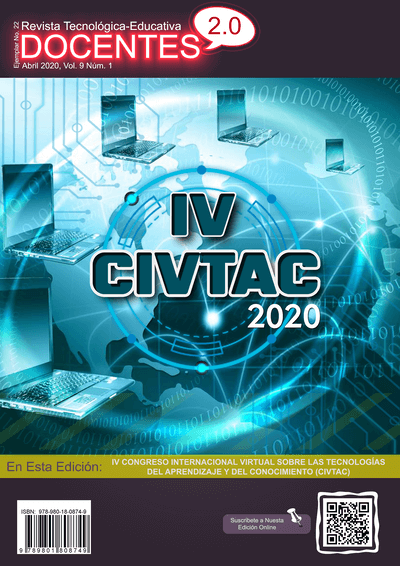GeoGebra implementation based on the resolution of perimeter and area problems
 DOI:
https://doi.org/10.37843/rted.v9i1.99
DOI:
https://doi.org/10.37843/rted.v9i1.99
Main Article Content
Abstract
The objective of this research was to propose the use of GeoGebra as a didactic resource aimed at the development of skills in the resolution of problems related to perimeter and area of ??flat figures, in the upper level of Basic General Education (BGE), in the area of ??Mathematics. This study was based on the advantages of GeoGebra when applied as a teaching resource. The focus of this research was mixed. The methodology was supported by documentary analysis, the application of a diagnostic test, a final test and surveys to diagnose the problem. The proposal consisted of the design of didactic sequences based on the use of GeoGebra. The implementation of the proposal was carried out in the 10th year of BGE in the Educational Unit "Ricardo Muñoz Chávez". Finally, in the evaluation of the proposal a comparative analysis of the results of the diagnostic test and the final test was performed. The results of the formative evaluation with the execution tasks were also analyzed. From the integration of the results, it was concluded that the students achieve a better performance in the skills involved in solving problems with perimeter and area.
Downloads
Metrics
Article Details

This work is licensed under a Creative Commons Attribution-NonCommercial-NoDerivatives 4.0 International License.
Those authors who have publications in our journal accept the following terms:
- When a work is accepted for publication, the author retains rights of reproduction, distribution of his/her article for exploitation in all countries of the world in the format provided by our magazine and any other magnetic medium, optical, and digital.
- Authors will retain their copyright and guarantee the journal the right first to publish their work, which will be simultaneously subject to the Creative Commons Acknowledgment License (Attribution-NonCommercial-NoDerivatives 4.0 International (CC BY-NC-ND 4.0)). That allows third parties to copy and redistribute the material in any medium or format, under the following conditions: Acknowledgment - You must properly acknowledge authorship, provide a link to the license, and indicate if any changes have been made. You may do so in any reasonable way, but not in a way that suggests you have the licensor's endorsement or receive it for your use. NonCommercial - You may not use the material for a commercial purpose. NoDerivatives - If you remix, transform, or build from the material, you cannot broadcast the modified material. There are no additional restrictions - You cannot apply legal terms or technological measures that legally restrict you from doing what the license allows.
- Authors may adopt other non-exclusive license agreements to distribute the published version of the work (e.g., deposit it in an institutional archive or publish it in a monographic volume) provided that the initial publication in this journal is indicated.
- Authors are allowed and recommended to disseminate their work through the Internet (e.g., in institutional telematic archives, repositories, libraries, or their website), producing exciting exchanges and increasing the published work's citations.
- Request of withdrawal an article has to be done in writing by the author to the Editor, becoming effective after a written response from the Editor. For this purpose, the author or authors will send correspondence via e-mail: [email protected].
- The author will not receive financial compensation for the publication of his work.
- All Docentes 2.0 Journal publications are under the Open Journal System (OJS) platform at: https://ojs.docentes20.com/.
References
Almenara, J. (2007). Las necesidades de las TIC en el ámbito educativo: oportunidades, riesgos y necesidades. Tecnología y comunicación educativas, 21(45), 5-19. https://cmapspublic2.ihmc.us/rid=1M92QZKRZ-XM42B8-1QZZ/caberne.pdf
Barahona, F., Barrera, O., Hidalgo, B., y Vaca, B. (2015). GeoGebra para la enseñanza de la matemática y su incidencia en el rendimiento académico estudiantil. Revista Tecnológica ESPOL, 28(5), 121-132. http://rte.espol.edu.ec/index.php/tecnologica/article/view/429/296
Ferragina, R. (2012). Geogebra entra al aula de matemática (2da. ed.). Miño y Dávila.
Flores, P., Lupiáñez, J., Berenger, L., Marín, A., y Molina, M. (2011). Materiales y recursos en el aula de matemáticas. http://hdl.handle.net/10481/21964
Hernández, R., Fernández, C. y Baptista, M. (2010). Metodología de la investigación. (5ta ed.). McGraw-Hill.
Moya, A. (2010). Recursos Didácticos en la Enseñanza. Revista Digital Innovación y Experiencias Educativas, 45, 1-9. https://archivos.csif.es/archivos/andalucia/ensenanza/revistas/csicsif/revista/pdf/Numero_26/ANTONIA_MARIA_MOYA_MARTINEZ.pdf
Riveros, V., Mendoza, M. y Castro, R. (2011). Las tecnologías de la información y la comunicación en el proceso de instrucción de la matemática. Quórum Académico, 8(15), 111-130. https://dialnet.unirioja.es/servlet/articulo?codigo=3999014






